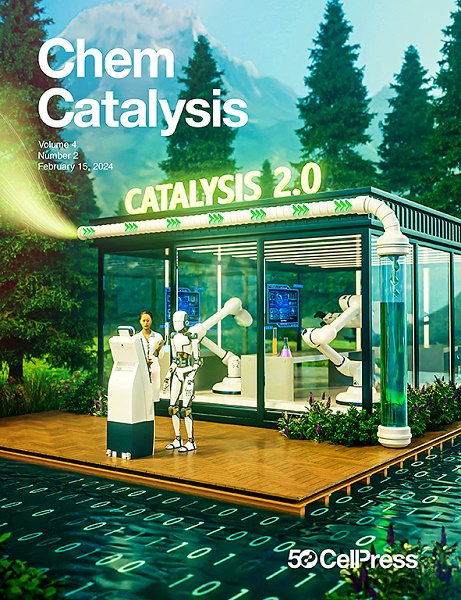腐蚀诱导CoCu微线阵列用于5-羟甲基糠醛的高效电还原
IF 11.5
Q1 CHEMISTRY, PHYSICAL
引用次数: 0
摘要
构建高性能电催化剂的腐蚀工程与生物质高效升级的交叉代表了两个充满活力、可持续的研究主题,当结合起来时,它们有望取得令人兴奋的成果。在这项研究中,我们在泡沫铜(CoCuMW/CF)上实现了5-羟甲基糠醛(HMF)在腐蚀诱导的CoCu微线阵列上高度选择性加氢到2,5-双(羟甲基)呋喃(BHMF)。在电化学过程中,HMF转化率为95.7%,BHMF产率为85.4%。机理研究表明,该反应途径主要由Langmuir-Hinshelwood (L-H)机制控制。密度泛函理论(DFT)计算表明,CoCu界面在HMF加氢过程中具有较低的自由能垒,显著提高了催化性能和BHMF选择性。腐蚀的诱导提高了铜基电催化剂的电化学加氢性能,对降低催化剂成本和加快HMF电加氢的应用具有重要价值。本文章由计算机程序翻译,如有差异,请以英文原文为准。

Corrosion-induced CoCu microwire arrays for efficient electroreduction of 5-hydroxymethylfurfural
The intersection of corrosion engineering for constructing high-performance electrocatalysts and the efficient upgrading of biomass represents two vibrant, sustainable research themes that promise exciting outcomes when combined. In this study, we achieve the highly selective hydrogenation of 5-hydroxymethylfurfural (HMF) to 2,5-bis(hydroxymethyl)furan (BHMF) over corrosion-induced CoCu microwire arrays on copper foam (CoCuMW/CF). An HMF conversion of 95.7% and a BHMF yield of 85.4% can be achieved in the electrochemical process. Mechanistic investigations indicate that the reaction pathway is primarily governed by the Langmuir-Hinshelwood (L-H) mechanism. Density functional theory (DFT) calculations reveal that the CoCu interface exhibits lower free energy barriers for the hydrogenation steps of HMF, which significantly enhances the catalytic performance and BHMF selectivity. The induction of corrosion enhances the electrochemical hydrogenation performance of the copper-based electrocatalyst, which holds significant value in reducing catalyst costs and accelerating the application of HMF electrohydrogenation.
求助全文
通过发布文献求助,成功后即可免费获取论文全文。
去求助
来源期刊
CiteScore
10.50
自引率
6.40%
发文量
0
期刊介绍:
Chem Catalysis is a monthly journal that publishes innovative research on fundamental and applied catalysis, providing a platform for researchers across chemistry, chemical engineering, and related fields. It serves as a premier resource for scientists and engineers in academia and industry, covering heterogeneous, homogeneous, and biocatalysis. Emphasizing transformative methods and technologies, the journal aims to advance understanding, introduce novel catalysts, and connect fundamental insights to real-world applications for societal benefit.

 求助内容:
求助内容: 应助结果提醒方式:
应助结果提醒方式:


